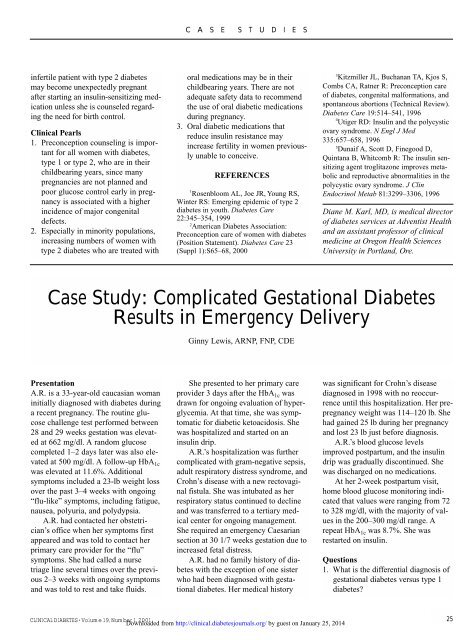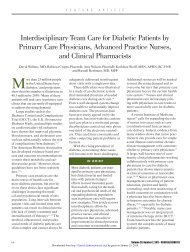C A S E S T U D I E Sinfertile patient with type 2 diabetesmay become unexpectedly pregnantafter starting an insulin-sensitizing medicationunless she is counseled regardingthe need for birth control.<strong>Clinical</strong> Pearls1. Preconception counseling is importantfor all women with diabetes,type 1 or type 2, who are in theirchildbearing years, since manypregnancies are not planned <strong>and</strong>poor glucose control early in pregnancyis associated with a higherincidence of major congenitaldefects.2. Especially in minority populations,increasing numbers of women withtype 2 diabetes who are treated withoral medications may be in theirchildbearing years. There are notadequate safety data to recommendthe use of oral diabetic medicationsduring pregnancy.3. Oral diabetic medications thatreduce insulin resistance mayincrease fertility in women previouslyunable to conceive.REFERENCES1 Rosenbloom AL, Joe JR, Young RS,Winter RS: Emerging epidemic of type 2diabetes in youth. <strong>Diabetes</strong> Care22:345–354, 19992American <strong>Diabetes</strong> Association:Preconception care of women with diabetes(Position Statement). <strong>Diabetes</strong> Care 23(Suppl 1):S65–68, 20003Kitzmiller JL, Buchanan TA, Kjos S,Combs CA, Ratner R: Preconception careof diabetes, congenital malformations, <strong>and</strong>spontaneous abortions (Technical Review).<strong>Diabetes</strong> Care 19:514–541, 19964Utiger RD: Insulin <strong>and</strong> the polycysticovary syndrome. N Engl J Med335:657–658, 19965Dunaif A, Scott D, Finegood D,Quintana B, Whitcomb R: The insulin sensitizingagent troglitazone improves metabolic<strong>and</strong> reproductive abnormalities in thepolycystic ovary syndrome. J ClinEndocrinol Metab 81:3299–3306, 1996Diane M. Karl, MD, is medical directorof diabetes services at Adventist Health<strong>and</strong> an assistant professor of clinicalmedicine at Oregon Health SciencesUniversity in Portl<strong>and</strong>, Ore.<strong>Case</strong> <strong>Study</strong>: Complicated Gestational <strong>Diabetes</strong>Results in Emergency DeliveryGinny Lewis, ARNP, FNP, CDEPresentationA.R. is a 33-year-old caucasian womaninitially diagnosed with diabetes duringa recent pregnancy. The routine glucosechallenge test performed between28 <strong>and</strong> 29 weeks gestation was elevatedat 662 mg/dl. A r<strong>and</strong>om glucosecompleted 1–2 days later was also elevatedat 500 mg/dl. A follow-up HbA 1cwas elevated at 11.6%. Additionalsymptoms included a 23-lb weight lossover the past 3–4 weeks with ongoing“flu-like” symptoms, including fatigue,nausea, polyuria, <strong>and</strong> polydypsia.A.R. had contacted her obstetrician’soffice when her symptoms firstappeared <strong>and</strong> was told to contact herprimary care provider for the “flu”symptoms. She had called a nursetriage line several times over the previous2–3 weeks with ongoing symptoms<strong>and</strong> was told to rest <strong>and</strong> take fluids.She presented to her primary careprovider 3 days after the HbA 1c wasdrawn for ongoing evaluation of hyperglycemia.At that time, she was symptomaticfor diabetic ketoacidosis. Shewas hospitalized <strong>and</strong> started on aninsulin drip.A.R.’s hospitalization was furthercomplicated with gram-negative sepsis,adult respiratory distress syndrome, <strong>and</strong>Crohn’s disease with a new rectovaginalfistula. She was intubated as herrespiratory status continued to decline<strong>and</strong> was transferred to a tertiary medicalcenter for ongoing management.She required an emergency Caesariansection at 30 1/7 weeks gestation due toincreased fetal distress.A.R. had no family history of diabeteswith the exception of one sisterwho had been diagnosed with gestationaldiabetes. Her medical historywas significant for Crohn’s diseasediagnosed in 1998 with no reoccurrenceuntil this hospitalization. Her prepregnancyweight was 114–120 lb. Shehad gained 25 lb during her pregnancy<strong>and</strong> lost 23 lb just before diagnosis.A.R.’s blood glucose levelsimproved postpartum, <strong>and</strong> the insulindrip was gradually discontinued. Shewas discharged on no medications.At her 2-week postpartum visit,home blood glucose monitoring indicatedthat values were ranging from 72to 328 mg/dl, with the majority of valuesin the 200–300 mg/dl range. Arepeat HbA 1c was 8.7%. She wasrestarted on insulin.Questions1. What is the differential diagnosis ofgestational diabetes versus type 1diabetes?CLINICAL DIABETES • Volume 19, NumberDownloaded1, 2001from http://clinical.diabetesjournals.org/ by guest on January 25, 201425
C A S E S T U D I E S2. At what point during pregnancyshould insulin therapy be institutedfor blood glucose control?3. How can communication systems bechanged to provide for integration ofinformation between multipleproviders?CommentaryGestational diabetes is defined as “anydegree of carbohydrate intolerancewith onset first recognized during pregnancy.This definition applies whetherinsulin … is used for treatment <strong>and</strong>whether or not the condition persistsafter pregnancy.” 1 Risk assessment isdone early in the pregnancy, with average-riskwomen being tested at 24–28weeks’ gestation <strong>and</strong> low-risk womenrequiring no additional testing. 1,2 A.R.met the criteria for average risk basedon age <strong>and</strong> a first-degree family memberwith a history of gestational diabetes.Screening criteria for diagnosingdiabetes include 1) symptoms of diabetesplus casual plasma glucose >200mg/dl (11.1 mmol/l), or 2) fasting plasmaglucose >126 mg/dl (7.0 mmol/l),or 3) 2-h plasma glucose >200 mg/dl(11.1 mmol/l) during an oral glucosetolerance test (OGTT). 3 For womenwho do not meet the first two criteria, aglucose challenge test (GCT) measuringa 1-h plasma glucose following a50-g oral glucose load is acceptable.For those women who fail the initialscreen, practitioners can then proceedwith the OGTT. 1In A.R.’s case, she most likelywould have met the first criterion if acasual blood glucose had been measured.She had classic symptoms withweight loss, fatigue, polyuria, <strong>and</strong> polydypsia.Her 1-h plasma glucose followingthe glucose challenge was >600mg/dl, which suggests that her casualglucose would also have been quitehigh.Medical nutrition therapy (MNT) iscertainly a major part of diabetes management.However, with this degree ofhyperglycemia, MNT would not beadequate as monotherapy. Treatmentfor gestational diabetes includes the useof insulin if fasting blood glucose levelsare >95 mg/dl (5.3 mmol/l) or 2-hpostpr<strong>and</strong>ial values are >120 mg/dl (6.7mmol/l). 1Several days passed from the timeof A.R.’s initial elevated blood glucosevalue <strong>and</strong> the initiation of insulin therapy.While HbA 1c values cannot be used fordiagnostic purposes, in this case theyfurther confirmed the significant degreeof hyperglycemia.Plasma blood glucose values initiallyimproved in the immediate postpartumperiod. A.R. was sent home withoutmedications but instructed tocontinue home glucose monitoring.At her 2-week postpartum visit,whole blood glucose values were againindicating progressive hyperglycemia,<strong>and</strong> insulin was restarted. A.R.’s postpartumweight was 104 lb—well belowher usual pre-pregnancy weight of114–120 lb. Based on her ethnic background,weight loss, abrupt presentationwith classic diabetes symptoms,<strong>and</strong> limited family history, she wasreclassified as having type 1 diabetes.In immune-mediated, or type 1, diabetes,-cell destruction can be variable,with a slower destruction sometimesseen in adults. 3 Presentation oftype 1 diabetes can also vary with modestfasting hyperglycemia that canquickly change to severe hyperglycemia<strong>and</strong>/or ketoacidosis in thepresence of infection or other stress. 3A.R. may have had mild hyperglycemiapre-pregnancy that increased in severityas the pregnancy progressed.The final issue is communicationamong multiple health care providers.A.R. was part of a system that uses primarycare providers, specialists, <strong>and</strong>triage nurses. She accessed all of theseproviders as instructed. However, theinformation did not seem to be clearlycommunicated among these differenttypes of providers. A.R. called triagenurses several times with her concernsof increased fatigue, nausea, <strong>and</strong>weight loss. The specialist performedher glucose challenge with follow-upthrough the primary care office. Itseems that if all of these providers hadthe full information about this case, thediagnosis could have been made moreeasily, <strong>and</strong> insulin could have been initiatedmore quickly.<strong>Clinical</strong> Pearls1. Hyperglycemia diagnosed duringpregnancy is considered to be gestationaldiabetes until it is reclassifiedin the postpartum period. Immunemediateddiabetes can cause mildhyperglycemia that is intensified withthe increased counterregulatory hormoneresponse during pregnancy.2. Insulin therapy needs to be institutedquickly for cases in which MNTalone is inadequate.3. The GCT is an appropriate screeningtest for an average-risk woman withno symptoms of diabetes. In the faceof classic symptoms of diabetes, acasual plasma glucose test can eliminatethe need for the glucose challenge.4. As part of the health care industry,we need to continue to work on informationsystems to track patient data<strong>and</strong> share data among multipleproviders. Patients can become lost inan ever-exp<strong>and</strong>ing system that relieson “protocols” <strong>and</strong> does not alwaysallow for individual differences or forcases with unusual presentation.REFERENCES1 Coustan DR, Carpenter MW: Thediagnosis of gestational diabetes. <strong>Diabetes</strong>Care 21 (Suppl. 2):B5–B8, 19982American <strong>Diabetes</strong> Association:Gestational diabetes mellitus (PositionStatement). <strong>Diabetes</strong> Care 23 (Suppl. 1):S77–S79, 20003 Expert Committee on the Diagnosis<strong>and</strong> Classification of <strong>Diabetes</strong> Mellitus:Report of the expert committee on the diagnosis<strong>and</strong> classification of diabetes mellitus.<strong>Diabetes</strong> Care 23 (Suppl. 1):S4–S19, 2000Ginny Lewis, ARNP, FNP, CDE, is anurse practitioner at the <strong>Diabetes</strong> CareCenter of the University of WashingtonSchool of Medicine in Seattle.26Volume 19, Number 1, 2001 •Downloaded from http://clinical.diabetesjournals.org/ by guest on January 25, 2014CLINICAL DIABETES




